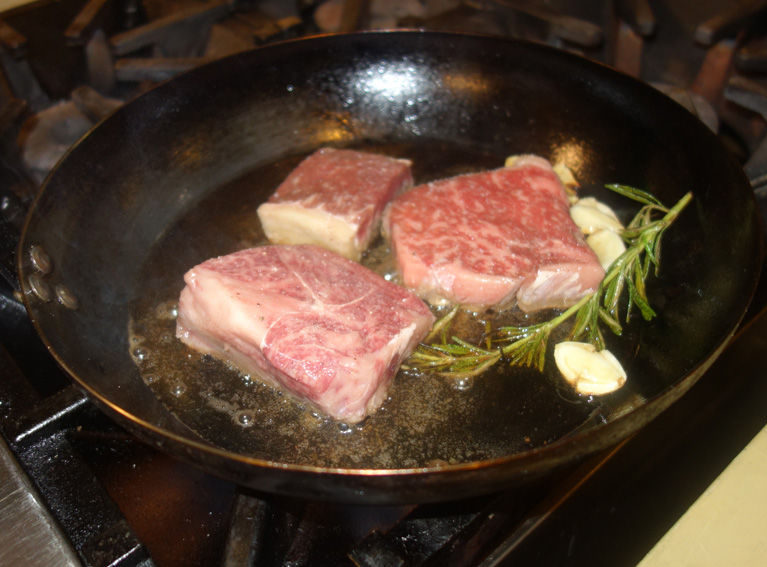
Last weekend, a couple dozen steak lovers had an extraordinary treat at Citrus Grillhouse – a chance to savor a real Japanese A5 Wagyu steak right here in Vero.
These were not the Wagyu steaks from Australia, or the American Wagyu Kobe steaks confusingly offered by so many U.S. restaurants.
These were the real thing, accompanied by a Certificate of Authenticity sealed with a nose print attesting that the steaks were from Kuroge Washu (Japanese Black) cattle raised on a specific farm in the prefecture of Miyazaki in Japan.
The A5 grade on the certificate – based on the marbling intensity, the color of the fat, the color of the muscle tissue itself, and the shape of the muscle – means that an inspector gave the steaks from this steer Japan’s highest score.
These were not, however, Kobe steaks. Many people (myself included) always thought Kobe and Wagyu were synonymous. Not true. All Kobe beef is Wagyu, but not all Wagyu is Kobe. Confused yet?
It turns out Kuroge is one of four pure Wagyu breeds raised in Japan (Kobe beef is a Tajima strain of Wagyu raised near Kobe City). We also learned that a Miyazaki Kuroge has beaten out a Kobe Tajima to win the last two of Japan’s Wagyu Olympics.
So what we were about to taste for the first time last Saturday night was even higher rated than Kobe steaks.
But instead of simply ordering dinner, Citrus Chef Scott Varricchio agreed to let us stage a three-way comparison between the Miyazaki Wagyu, a Wagyu steak from Australia, and a nice cut of prime American beef.
First we sampled the domestic steak (not, by the way, the American Wagyu – which generally is a cross breed of Wagyu and Angus). As is the case with any fine piece of American prime beef, this steak was nicely marbled, had a great texture and was very flavorful. We like the taste of American beef, have certainly enjoyed many steaks like this over the years, and look forward to many more.
Then we moved to the Australian Wagyu. The Australian Wagyu herd was founded on live animals and genetic material first imported in the 1990s, and we previous had tried Australian Wagyu steaks on several occasions at the Citrus. Unlike Japanese Wagyu, you see the Australian Wagyu from time to time on the menu of fine restaurants.
In our experience, the Australian Wagyu is an excellent steak – in appearance and taste closer to the Japanese Wagyu than to American beef, with high marbling and speckled with fat evenly distributed throughout. The flavor is mild but rich. Could the Japanese Wagyu actually be better, we wondered?
Oh, my! I took my first bite of the Miyazaki Wagyu – and it literally melted in my mouth (the oleic acid in Waygu beef fat melts at 65 degrees, while some of the other fatty acids melt at even lower temperatures; the fat dissolving in your mouth is what Waygu producers claim makes the beef so rich and buttery).
The only word I can think of to describe eating Miyazaki Wagyu is decadent – which probably is why the steaks served by Citrus were five to six ounces. You wouldn’t want to eat a 12-ouncer as you would a U.S. Angus prime. It would, as one chef remarked, be like eating sticks of butter.
But do you really need to know as much as you’ve read here to be sure you are getting the real Japanese Waygu.
Unfortunately, yes. The ads you see for restaurants, and even fast-food joints, featuring Kobe burgers, Kobe hotdogs, and Wagyu sliders are a bit misleading, to put it gently. Even some of America’s best known restaurants have played fast and loose with what they offered as Kobe steaks. But the Japanese did not have the success in protecting their trademark that the French had with the word “Champagne.”
The fact is that while many Americans think that somewhere along the line they have ordered Kobe or Japanese Wagyu beef, few have ever tasted the real thing.
Before you shell out the big bucks that a Japanese Wagyu steak will cost (the Citrus was virtually giving it away last weekend for $75), you might want to ask to see the Certificate of Authenticity.
Even you can’t read the Japanese, your taste buds should start watering when you see the cow’s nose print.



